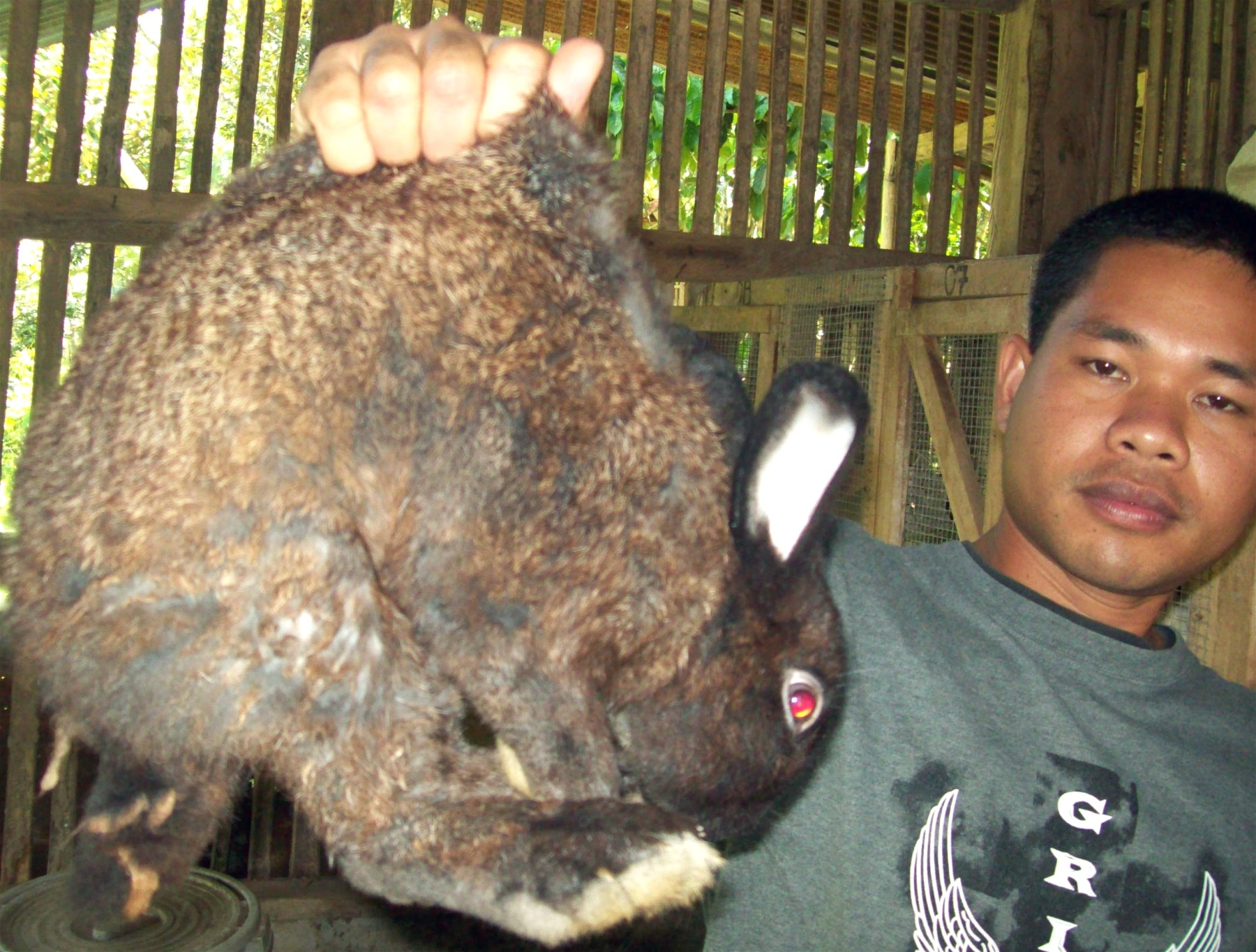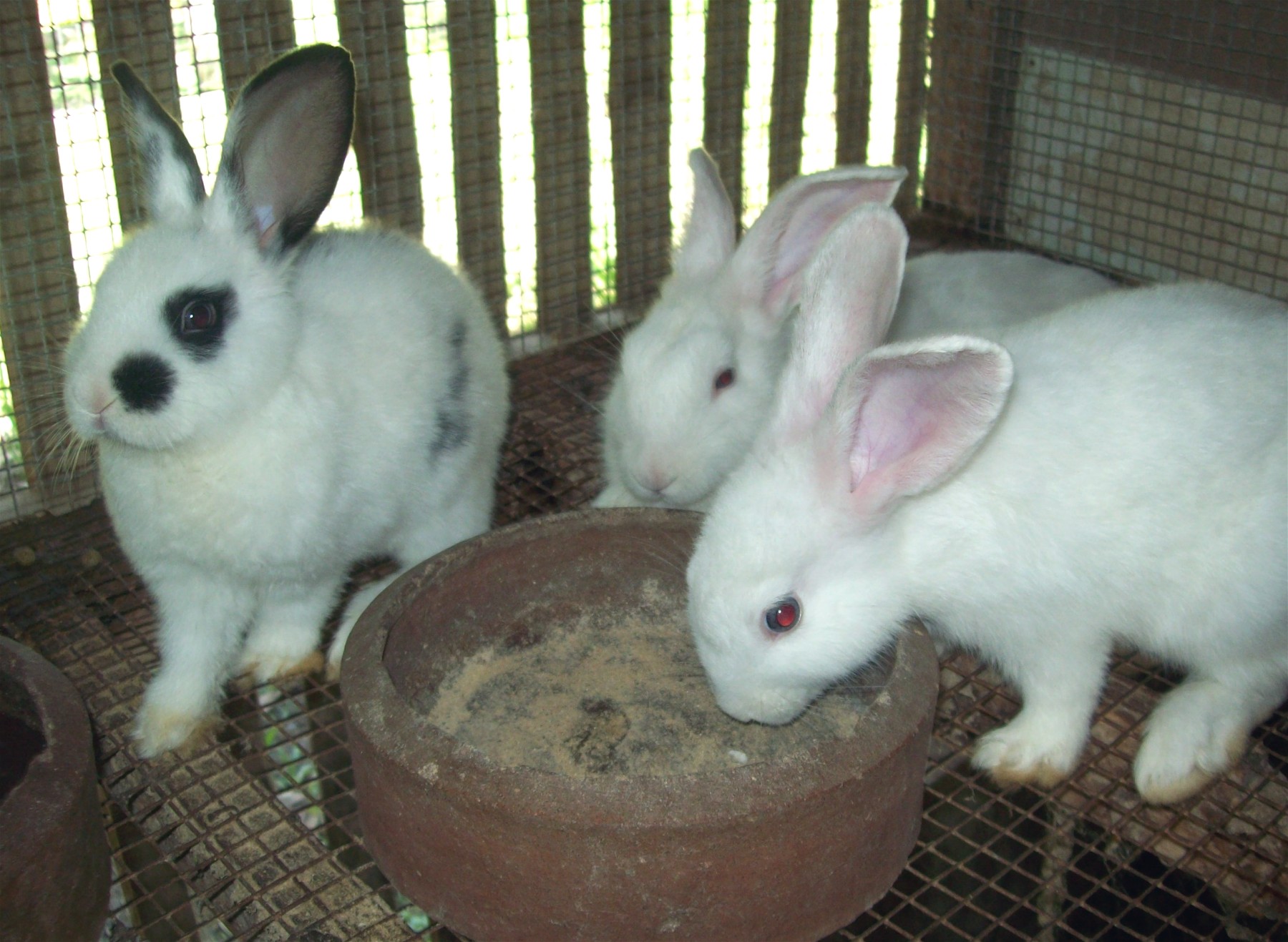Text and Photos by Henrylito D. Tacio
Rabbit meat was commonly consumed during the mid-20th century as a wartime food. “Rabbit meat is eaten in various other countries as well, including Malta, France, Italy, and China,” wrote Siddhi Camila Lama for livestrong.com. In the United States, rabbit is considered “a specialty meat.”
The website, riseandshinerabbitry.com, enumerates ten reasons why a person should eat rabbit meat: best white meats available on the market; a high percentage of easily digestible protein; least amount of fat among all the other available meats; contains less calorie value than other meats; almost cholesterol-free; sodium content is comparatively less than other meats; calcium and phosphorus contents is more than any other meats; there is more edible meat on the carcass than chicken; many health benefits that do not have a strong flavor; and one of the most productive domestic livestock there is.
Lama said that for every 100 grams of domestic rabbit, you get: 20.1 grams of protein, 40% of the daily value (DV); 9% of the DV for iron; 7% of the DV for potassium; 5% of the DV for magnesium; 17% of the DV for phosphorus; 14% of the DV for zinc; 43% of the DV for selenium; 29% of the DV for vitamin B12; 8% of the DV for thiamin; 12% of the DV for riboflavin; 45% of the DV for niacin; 16% of the DV for vitamin B5; and 29% of the DV for vitamin B6.
“The fat content of rabbit meat is fairly low in comparison to other proteins, making lean meat,” Lama wrote. The Rome-based Food and Agriculture Organization (FAO) of the United Nations considered rabbit meat as having “one of the lowest fat amounts and highest protein amounts of many typically consumed meats.”
“In every 100 grams of domesticated rabbit, you will find 5.6 grams of fat,” Lama wrote. “Saturated fat makes up 1.7 of these grams.” The 2013 study published in the Journal of Animal Production Advances contends the amount is “much less fat than in other widely consumed meats like pork and beef.”
Here’s another good reason for eating rabbit meat. “Although it is low in fat, rabbit meat is rich in healthy monounsaturated and polyunsaturated fats, like omega fatty acids,” Lama wrote. “There are 220 milligrams of omega-3 fatty acids and 860 milligrams of omega-6 fatty acids in every 100 grams of domesticated rabbit meat.”
Farmers who will raise rabbits need to know that the animals are very prolific. They breed three to four times a year, livescience.com reports. “Each pregnancy produces three to eight babies, called kittens or kits,” it says. “After four to five weeks, a kit can care for itself. In two to three months, it is ready to start a family of its own.”
There is indeed a bright future for rabbit farming. “Producing plenty of rabbit meat for Filipinos will help alleviate the malnutrition problem, especially in children,” says Jethro P. Adang, the director of Mindanao Baptist Rural Life Center (MBRLC) Foundation, Inc.
With the soaring cost of pork, beef, and other meats, the rabbit will soon gain more consumers, especially in those areas where meat is very scarce. In fact, the demand for rabbits at the MBRLC has been increasing through the years. People from different parts of the region are visiting the center – located at barangay Kinuskusan in Bansalan, Davao del Sur – just to buy rabbits.
Adang says rabbit culture is fairly easy, and the animals are economical to share. “It is easier than raising chickens because rabbits need little space, capital, and attention,” he points out. “These small animals also multiply quickly. They are ideal for backyard projects for low-income rural families.”


For those who want to raise rabbits, here are some tips from the MBRLC:
Housing: Rabbits can be raised in a small space, and they need only inexpensive equipment. For a backyard project, it is necessary to build hutches (cages). The cage should be located in a quiet place.
Avoid constructing the rabbit house in an area where it could be hit directly by sunlight. Provide nylon curtains or empty feed sacks in the front and back of the cage to protect rabbits from rain and strong wind. Roll up the curtain during the daytime when there is no rain.
Each rabbit should have at least 8 square feet of floor space, although 10 square feet is better. A good pen size is 2.5 feet long by 4 feet wide by 2 feet high. As rabbits are territorial, each must be housed in a separate pen. Buck and doe must be separated.
Breeding stock: Select young rabbits, which are offspring of prolific does which know how to suckle or nurse their young. As for the buck, select those that are aggressive and well-developed. Both the buck and doe should be vigorous and healthy and free from defects and diseases.
Ideally, you should start with one male and two females. It is best to buy them at two months old, right after they are weaned. Be sure to buy your breeding stock from reliable sources.
Feeding: Rabbits are voracious eaters. Their diet may consist of a mixture of legumes, grasses, camote tops, and tubers. Bean and pea leaves, kudzu, centrosema, and ipil-ipil are good sources of protein plant material, although you must be careful not to give more than 5 percent ipil-ipil. It is good to supplement with other available greens, so feel free to experiment. But minimize feeding of kangkong to your rabbits.
You will also need to feed some form of concentrate to get maximum production. Feed millers sell concentrates good for rabbits. Chicken feed can also be used. If pellets are available, they can be mixed with other kinds of feed. Give one ounce of concentrate mixed with green feeds and leftovers to a 2-month old rabbit twice daily. Give four ounces of concentrates mixed with green feed to more than 3-month old rabbits.
Provide plenty of fresh, clean water and salt at all times. The rabbits drink plenty of water, especially during lactation. Feeds should be given twice a day: once in the morning and once in the afternoon.
Do not overfeed your rabbits or lessen their consumption. If you give your rabbit too much, it will become fat and may have problems breeding, and if a doe becomes too fat, it is likely that she will have trouble when kindling. If you give them too little feed, then they will, obviously, become too skinny and be more prone to diseases.
Breeding: A small breed doe is normally ready to mate when she is five months old, and a buck is ready at six months. The medium-sized doe is ready to breed when she is six months old and the buck at seven months. The heavy breed doe is ready at eight months, and the buck is ready at nine months.
It is very important that you take the female to the pen of the male for breeding. Do not place the male in the pen of the female. The male should serve the female two times. If the female runs from the male, restrain her or take her out and place her back with the male the following day.
Inbreeding, avoid the hot hours of the day. Breed rabbits early in the morning (from 5:00 to 8:00 a.m.) or late in the afternoon (from 4:00 to 7:00 p.m.). Do not leave the female in the pen overnight with the male.
Kindling: The doe gestates for 29 to 32 days. Place a box-shape next (12” x 24” x 12”) in the hutch one week before kindling. Three or four days before giving birth, it prepares its nest sheds some of its fur for lining the nests. Do not disturb the doe during kindling. Wait 24 hours after kindling to look at the babies and to remove any that are dead.
At kindling time, the doe will be extremely nervous. As much as possible, keep children, dogs, cats, and other animals away.
Care and management: When baby rabbits show signs of sickness, dissolve one-half teaspoon of Sulmet in one liter of water. Give this solution for three days. (Terramycin powder can also be used in lieu of Sulmet.)
The baby rabbits will come out of the nest box after ten days and begin to eat greens and concentrates at three weeks. After two months, they are ready to be weaned. At this time, the mother should be rebred and the young fattened to be butchered at five months.
Record keeping: It is a good idea to keep records for good management and control of the stock. The basic information which should be recorded are: age of the doe, date doe was bred, expected date of delivery, and the number of young weaned per litter. You must know when to prepare the doe for kindling to prevent the loss of her young. The more you know about each doe, the better you will be able to distinguish between a quality doe and one which should be replaced.
Rabbits are not only good for their meat. They are very good producers of manure; additionally, their urine, being high in nitrogen, makes crops very productive. Their milk may also be of great medicinal or nutritional benefit due to its high protein content. Rabbit pelts are sometimes used for clothing and accessories, such as scarves or hats.

